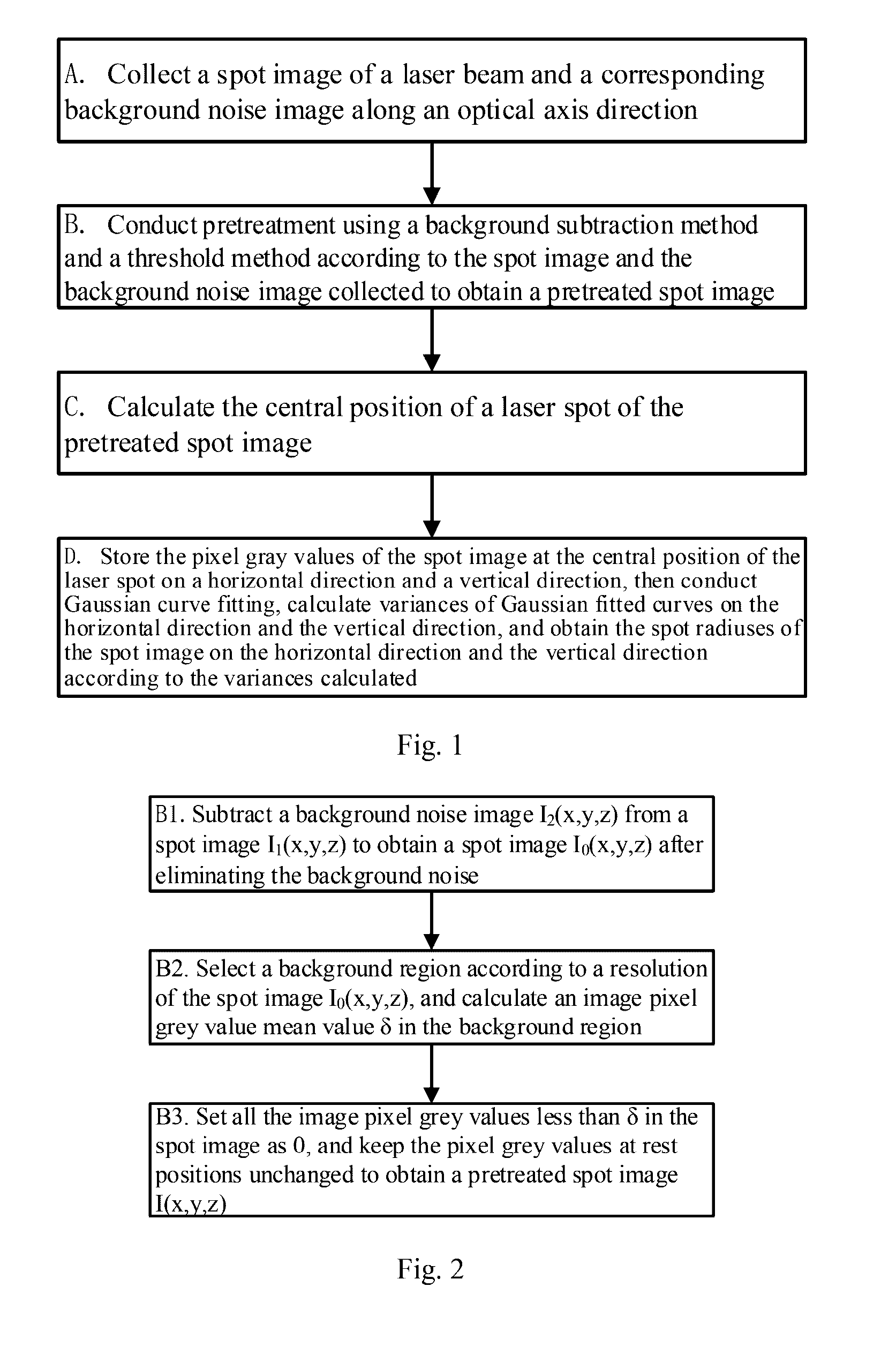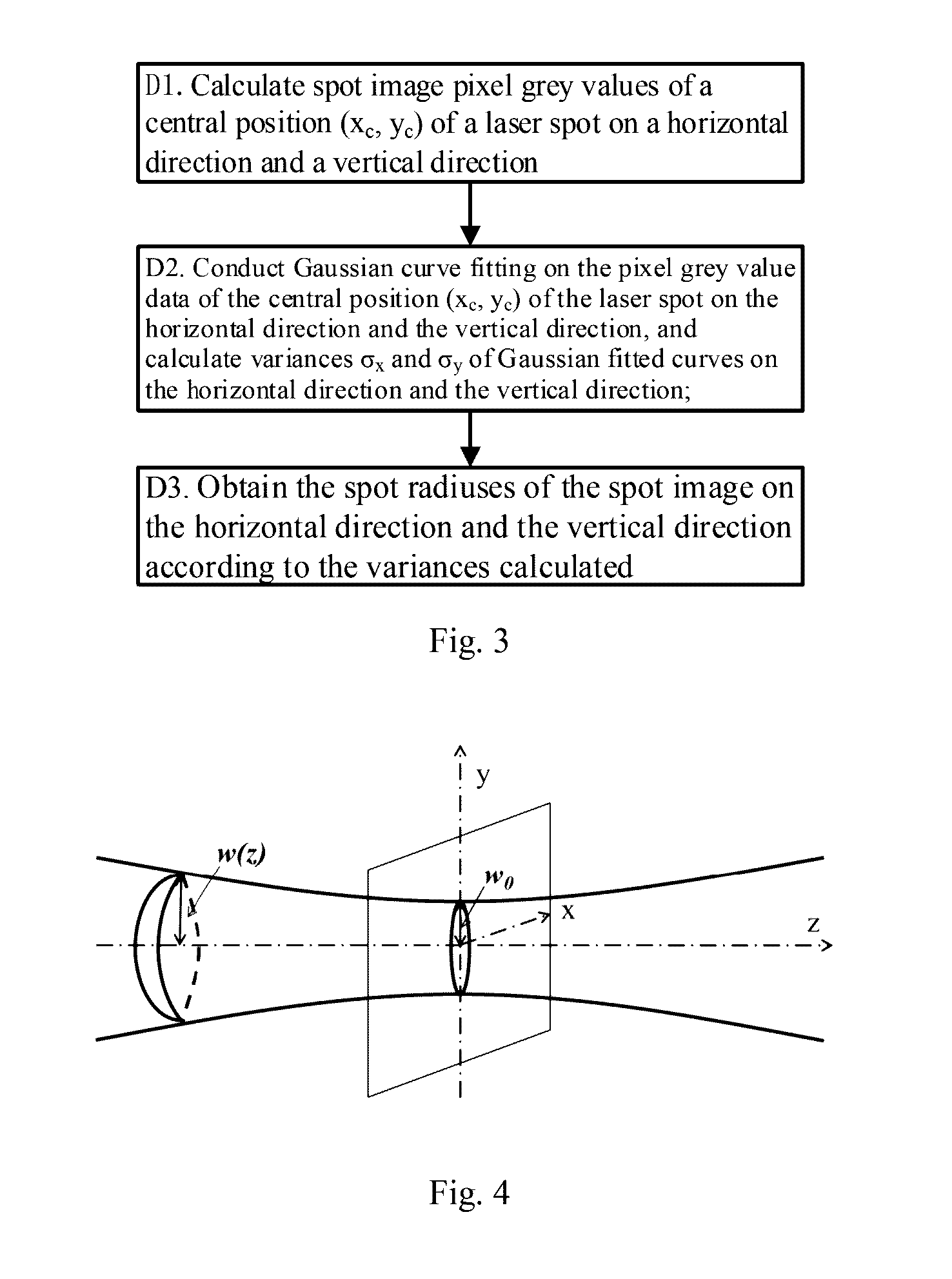Method and system for calculating laser beam spot size
a laser beam and spot size technology, applied in the field of optical information acquisition and process, can solve the problems of poor robustness, relative difficulty in actual operation, complicated operation, etc., and achieve the effect of simple operation, high precision and simple principl
- Summary
- Abstract
- Description
- Claims
- Application Information
AI Technical Summary
Benefits of technology
Problems solved by technology
Method used
Image
Examples
first embodiment
[0061]Relevant theory and principle of the method for calculating laser beam spot size according to the invention are explained in the embodiment.
[0062]For the laser beam produced in a stable cavity with characters and spreading rules of completely different from that of a common spherical wave or plane wave, all possible types of the laser waveform are referred to as laser beam or Gaussian beam in the disclosure. FIG. 4 shows a schematic view of the laser beam spreading along an optical axis direction; no matter the field is produced by a stable cavity of any structure, the complex amplitude distribution of a field of the Gaussian beam spreading along the z axis direction can be represented in a general form as shown in the following formula (1):
E(x,y,z)=cw(z)-x2+y2w2(z)-[k(z+x2+y22R(z))-arctgzf](1)
[0063]In formula (1), x and y belong to a plane-coordinate system of a cross section of the laser beam, z indicates the direction of the laser beam spreading along an optical axis, c is ...
second embodiment
[0072]The calculation process and calculation results on the ideal laser beam spot sizes are explained in the embodiment.
[0073]FIG. 5 shows ideal laser beam spot images with different spot sizes, wherein the image resolutions are all 1025×1025, a central pixel position of the spot is (513, 513), a pixel size is 5.2 μm, and the spot sizes on the horizontal direction and the vertical direction are the same. Theoretical spot radiuses respectively corresponding to FIG. 5(a)-FIG. 5(e) respectively are 0.2 mm, 0.4 mm, 0.6 mm, 0.8 mm, and 1.0 mm in sequence.
[0074]FIG. 6 shows a schematic view of ideal laser beam spot sizes calculated using the method of the invention; a point of intersection of dotted lines on the horizontal direction and the vertical direction represents an ideal laser beam spot center, and a full line represents an ideal laser beam spot size, wherein an actual calculation data sheet is as shown in the following Table 1.
TABLE 1ActuallyActuallyActuallyActuallymeasuredmeasu...
third embodiment
[0079]A calculation process and calculation results on the laser beam spot image with different exposure time are explained in the embodiment.
[0080]FIG. 9 shows actual laser beam spot images with different exposure time. The exposure time of an industrial camera is adjusted, and spot images are collected at a certain position; the image resolutions are all set as 1280×1024, a pixel size is 5.2 μm, and exposure time respectively corresponding to FIG. 9(a)-FIG. 9(f) is 130 ms, 170 ms, 210 ms, 250 ms, 270 ms, and 290 ms in sequence.
[0081]As shown in FIG. 10, the method of the invention is employed to calculate actual laser beam spot sizes under different exposure time, wherein a point of intersection of dotted lines on the horizontal direction and the vertical direction represent an actual beam spot center, and a full time represents an actual laser beam spot size; when the exposure time is 250 ms, the pixel grey value of the spot image reaches a saturation state. An actual calculation...
PUM
 Login to View More
Login to View More Abstract
Description
Claims
Application Information
 Login to View More
Login to View More - R&D
- Intellectual Property
- Life Sciences
- Materials
- Tech Scout
- Unparalleled Data Quality
- Higher Quality Content
- 60% Fewer Hallucinations
Browse by: Latest US Patents, China's latest patents, Technical Efficacy Thesaurus, Application Domain, Technology Topic, Popular Technical Reports.
© 2025 PatSnap. All rights reserved.Legal|Privacy policy|Modern Slavery Act Transparency Statement|Sitemap|About US| Contact US: help@patsnap.com



